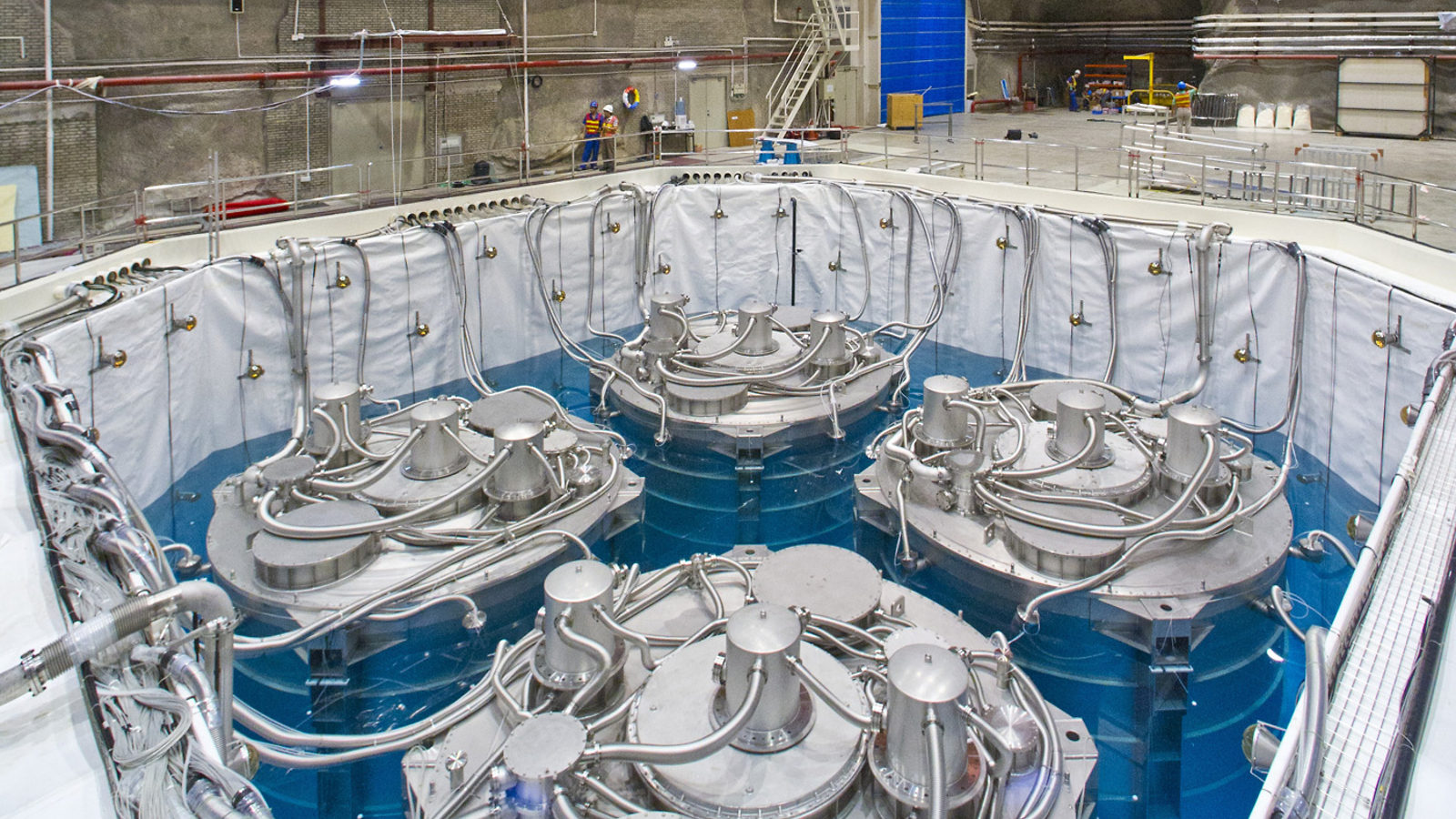As nuclear reactors burn through fuel, they produce a steady flow of particles called neutrinos. Neutrinos interact so rarely with other matter that they can flow past the steel and concrete of a power plant’s containment structures and keep on moving through anything else that gets in their way.
Physicists interested in studying these wandering particles have taken advantage of this fact by installing neutrino detectors nearby. A recent result using some of these detectors demonstrated both their limitations and strengths.
The reactor antineutrino anomaly
In 2011, a group of theorists noticed that several reactor-based neutrino experiments had been publishing the same, surprising result: They weren’t detecting as many neutrinos as they thought they would.
Or rather, to be technically correct, they weren’t seeing as many antineutrinos as they thought they would; nuclear reactors actually produce the antimatter partners of the elusive particles. About 6 percent of the expected antineutrinos just weren’t showing up. They called it “the reactor antineutrino anomaly.”
The case of the missing neutrinos was a familiar one. In the 1960s, the Davis experiment located in Homestake Mine in South Dakota reported a shortage of neutrinos coming from processes in the sun. Other experiments confirmed the finding. In 2001, the Sudbury Neutrino Observatory in Ontario demonstrated that the missing neutrinos weren’t missing at all; they had only undergone a bit of a costume change.
Neutrinos come in three types. Scientists discovered that neutrinos could transform from one type to another. The missing neutrinos had changed into a different type of neutrino that the Davis experiment couldn’t detect.
Since 2011, scientists have wondered whether the reactor antineutrino anomaly was a sign of an undiscovered type of neutrino, one that was even harder to detect, called a sterile neutrino.
A new result from the Daya Bay experiment in China not only casts doubt on that theory, it also casts doubt on the idea that scientists understand their model of reactor processes well enough at this time to use it to search for sterile neutrinos.
The word from Daya Bay
The Daya Bay experiment studies antineutrinos coming from six nuclear reactors on the southern coast of China, about 35 miles northeast of Hong Kong. The reactors are powered by the fission of uranium. Over time, the amount of uranium inside the reactor decreases while the amount of plutonium increases. The fuel is changed—or cycled—about every 18 months.
The main goal of the Daya Bay experiment was to look for the rarest of the known neutrino oscillations. It did that, making a groundbreaking discovery after just nine weeks of data-taking.
But that wasn’t the only goal of the experiment. “We realized right from the beginning that it is important for Daya Bay to address as many interesting physics problems as possible,” says Daya Bay co-spokesperson Kam-Biu Luk of the University of California, Berkeley and the US Department of Energy’s Lawrence Berkeley National Laboratory.
For this result, Daya Bay scientists took advantage of their enormous collection of antineutrino data to expand their investigation to the reactor antineutrino anomaly.
Using data from more than 2 million antineutrino interactions and information about when the power plants refreshed the uranium in each reactor, Daya Bay physicists compared the measurements of antineutrinos coming from different parts of the fuel cycle: early ones dominated by uranium through later ones dominated by both uranium and plutonium.
In theory, the type of fuel producing the antineutrinos should not affect the rate at which they transform into sterile neutrinos. According to Bob Svoboda, chair of the Department of Physics at the University of California, Davis, “a neutrino wouldn’t care how it got made.” But Daya Bay scientists found that the shortage of antineutrinos existed only in processes dominated by uranium.
Their conclusion is that, once again, the missing neutrinos aren’t actually missing. This time, the problem of the missing antineutrinos seems to stem from our understanding of how uranium burns in nuclear power plants. The predictions for how many antineutrinos the scientists should detect may have been overestimated.
“Most of the problem appears to come from the uranium-235 model (uranium-235 is a fissile isotope of uranium), not from the neutrinos themselves,” Svoboda says. “We don’t fully understand uranium, so we have to take any anomaly we measured with a grain of salt.”
This knock against the reactor antineutrino anomaly does not disprove the existence of sterile neutrinos. Other, non-reactor experiments have seen different possible signs of their influence. But it does put a damper on the only evidence of sterile neutrinos to have come from reactor experiments so far.
Other reactor neutrino experiments, such as NEOS in South Korea and PROSPECT in the United States will fill in some missing details. NEOS scientists directly measured antineutrinos coming from reactors in the Hanbit nuclear power complex using a detector placed about 80 feet away, a distance some scientists believe is optimal for detecting sterile neutrinos should they exist. PROSPECT scientists will make the first precision measurement of antineutrinos coming from a highly enriched uranium core, one that does not produce plutonium as it burns.
A silver lining
The Daya Bay result offers the most detailed demonstration yet of scientists’ ability to use neutrino detectors to peer inside running nuclear reactors.
“As a study of reactors, this is a tour de force,” says theorist Alexander Friedland of SLAC National Accelerator Laboratory. “This is an explicit demonstration that the composition of the reactor fuel has an impact on the neutrinos.”
Some scientists are interested in monitoring nuclear power plants to find out if nuclear fuel is being diverted to build nuclear weapons.
“Suppose I declare my reactor produces 100 kilograms of plutonium per year,” says Adam Bernstein of Lawrence Livermore National Laboratory. “Then I operate it in a slightly different way, and at the end of the year I have 120 kilograms.” That 20-kilogram surplus, left unmeasured, could potentially be moved into a weapons program.
Current monitoring techniques involve checking what goes into a nuclear power plant before the fuel cycle begins and then checking what comes out after it ends. In the meantime, what happens inside is a mystery.
Neutrino detectors allow scientists to understand what’s going on in a nuclear reactor in real time.
Scientists have known for decades that neutrino detectors could be useful for nuclear nonproliferation purposes. Scientists studying neutrinos at the Rovno Nuclear Power Plant in Ukraine first demonstrated that neutrino detectors could differentiate between uranium and plutonium fuel.
Most of the experiments have done this by looking at changes in the aggregate number of antineutrinos coming from a detector. Daya Bay showed that neutrino detectors could track the plutonium inventory in nuclear fuel by studying the energy spectrum of antineutrinos produced.
“The most likely use of neutrino detectors in the near future is in so-called ‘cooperative agreements,’ where a $20-million-scale neutrino detector is installed in the vicinity of a reactor site as part of a treaty,” Svoboda says. “The site can be monitored very reliably without having to make intrusive inspections that bring up issues of national sovereignty.”
Luk says he is dubious that the idea will take off, but he agrees that Daya Bay has shown that neutrino detectors can give an incredibly precise report. “This result is the best demonstration so far of using a neutrino detector to probe the heartbeat of a nuclear reactor.”







